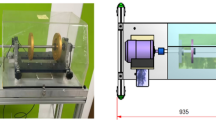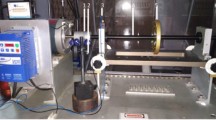Abstract
In this work, novel Linear Discriminant Analysis (LDA) based indicator has been developed for the detection of unbalance and misalignment at different shaft speeds. The process started with the acquisition of shaft displacement data in fixed time increment. Adaptive resampling of the acquired data was carried to convert time domain data to angular domain. Further, spectrum of angular domain signal was computed. Features were extracted from angular domain vibration signal and its spectrum. Then, LDA of features was done to form linear mapping and 1-D feature. The 1-D feature acts as indicator to discriminate between unbalance and misalignment condition. The experimental result indicate that developed LDA based feature is able to differentiate misalignment and unbalance irrespective of shaft speed by processing data in the angular domain. Using the developed indicator, machine operator will be able to easily determine the presence of unbalance and misalignment in shaft and corrective measures can be taken timely.















Similar content being viewed by others

References
Al-Hussain KM, Redmond I (2002) Dynamic response of two rotors connected by rigid mechanical coupling with parallel misalignment. J Sound Vib 249:483–498
Heo JW, Chung J (2004) Vibration analysis of a flexible rotating disk with angular misalignment. J Sound Vib 274:821–841
Sinha JK, Lees AW, Friswell MI (2004) Estimating unbalance and misalignment of a flexible rotating machine from a single run-down. J Sound Vib 272:967–989
Hili MA, Fakhfakh T, Haddar M (2006) Failure analysis of a misaligned and unbalanced flexible rotor. J Fail Anal Prev 6:73–82. https://doi.org/10.1361/154770206X117540.
Jalan AK, Mohanty AR (2009) Model based fault diagnosis of a rotor–bearing system for misalignment and unbalance under steady-state condition. J Sound Vib 327:604–622
Saxena A, Parey A, Chouksey M (2015) Effect of shaft misalignment and friction force on time varying mesh stiffness of spur gear pair. Eng Fail Anal 49:79–91
Tuckmantel F, Cavalca K (2019) Vibration signatures of a rotor-coupling-bearing system under angular misalignment. Mech Mach Theory 133:559–583
Patel T, Darpe AK (2009) Experimental investigations on vibration response of misaligned rotors. Mech Syst Sig Process 23:2236–2252
Gama AL, Lima WB, Veneza JPS (2017) Detection of shaft misalignment using piezoelectric strain sensors. Exp Tech. https://doi.org/10.1007/s40799-016-0158-x
Sudhakar GNDS, Sekhar AS (2011) Identification of unbalance in a rotor bearing system. J Sound Vib 330:2299–2313
Chacon JLF, Andicoberry EA, Kappatos V, Asfis G, Gan T-H, Balachandran W (2014) Shaft angular misalignment detection using acoustic emission. Appl Acoust 85:12–22
Reddy MCS, Sekhar AS (2015) Detection and monitoring of coupling misalignment in rotors using torque measurements. Measurement. 61:111–122
Nembhard AD, Sinha JK, Yunusa-Kaltungo A (2015) Experimental observations in the shaft orbits of relatively flexible machines with different rotor related faults. Measurement. 75:320–337
Verucchi C, Bossio J, Bossio G, Acosta G (2016) Misalignment detection in induction motors with flexible coupling by means of estimated torque analysis and MCSA. Mech Syst Sig Process 80:570–581
Wang N, Jiang D (2018) Vibration response characteristics of a dual-rotor with unbalance-misalignment coupling faults: theoretical analysis and experimental study. Mech Mach Theory 125:207–219
Sawalhi N, Ganeriwala S, Tóth M (2019) Parallel misalignment modeling and coupling bending stiffness measurement of a rotor-bearing system. Appl Acoust 144:124–141
Simm A, Wang Q, Huang S, Zhao W (2016) Laser based measurement for the monitoring of shaft misalignment. Measurement. 87:104–116
Zhang X, Yin Z, Dong Q (2019) An experimental study of axial misalignment effect on seizure load of journal bearings. Tribol Int 131:476–487
Wu J-D, Huang C-W, Chen J-C (2005) An order-tracking technique for the diagnosis of faults in rotating machineries using a variable step-size affine projection algorithm. NDT Int 38:119–127
Hui L, Zhang Y, Zheng H (2009) Gear fault detection and diagnosis under speed-up condition based on order cepstrum and radial basis function neural network. J Mech Sci Technol 23:2780–2789
Wang J, Gao RX, Yan R (2014) Multi-scale enveloping orders spectrogram for rotating machine health diagnosis. Mech Syst Sig Process 46:28–44
Qi X, Yuan Z, Han X (2015) Diagnosis of misalignment faults by tacholess order tracking analysis and RBF networks. Neurocomputing. 169:439–448
Maaten LJP (2007) An introduction to dimensionality reduction using Matlab. Universiteit Maastricht. The Netherlands, report MICC 07-07
Haeb-Umbach R, Ney H (1992) Linear discriminant analysis for improved large vocabulary continuous speech recognition. 1992 ICASSP-92, 1992 IEEE International Conference on Acoustics, Speech, and Signal Processing 1:13–16. doi: https://doi.org/10.1109/ICASSP.1992.225984
Chan HP, Wei D, Helvie MA et al (1995) Computer-aided classification of mammographic masses and normal tissue: linear discriminant analysis in texture feature space. Phys Med Biol 40:857–876. https://doi.org/10.1088/0031-9155/40/5/010
Xue M, Liu W, Liu X (2013) A novel weighted fuzzy LDA for face recognition using the genetic algorithm. Neural Comput & Applic 22:1531–1541. https://doi.org/10.1007/s00521-012-0962-x
Song X, Liu Z, Yang X, Yang J, Qi Y (2015) Extended semi-supervised fuzzy learning method for nonlinear outliers via pattern discovery. Appl Soft Comput 29:245–255
Acknowledgements
Authors are thankful to Editor for facilitating reviewer’s feedback to the manuscript. The valuable suggestions of anonymous reviewers in improving the manuscript are thankfully acknowledged.
Author information
Authors and Affiliations
Corresponding author
Ethics declarations
Conflict of Interest
Authors declare that there is no actual or potential conflict of interest in relation to this article.
Additional information
Publisher’s Note
Springer Nature remains neutral with regard to jurisdictional claims in published maps and institutional affiliations.
Rights and permissions
About this article
Cite this article
Kumar, A., Kumar, R. Development of LDA Based Indicator for the Detection of Unbalance and Misalignment at Different Shaft Speeds. Exp Tech 44, 217–229 (2020). https://doi.org/10.1007/s40799-019-00349-5
Received:
Accepted:
Published:
Issue Date:
DOI: https://doi.org/10.1007/s40799-019-00349-5



